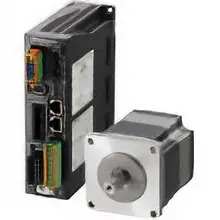What is the Difference Between "Pulse Input Type" and "Built-in Controller Type" Stepper Motor Drivers?


-

Mr. Vex, why are you staring at our catalog like that?
-

A customer is going to use a stepper motor for the first time and asked me to select a model for him.
-

I see. Have you heard the customer's required conditions?
-

Since it was his first time, he said he wanted to use the simplest system as possible.
What products should I introduce to make a simple system with stepper motors? -

Why don't you start by thinking about the basic setup of stepper motors? What is the minimum requirement?
-

Makes me think of when I first joined the company! You need a motor, a driver, and a controller for pulse oscillation. [Figure 1]
-

That's right. He'll also need something to transmit the start command to the controller. But do all stepper motors use this system?
![[Figure 1]](/sites/default/files/image/tech/eng-note/vol33/eng-note_vol33_01_en.gif)
-

Let's see...oh, by the way, there are cases where a controller is not needed! There are types that have a controller function built into the driver. [Figure 2]
-

That's right. What is that type called?
-

It is called a "built-in controller type." And the type that requires a separate controller [Figure 1] is a "pulse input type"!
![[Figure 2]](/sites/default/files/image/tech/eng-note/vol33/eng-note_vol33_02_en.gif)
-

That's correct. So, do you know what the benefits of each are?
-

Well, if we want to make a simple system like this customer, then I think the "built-in controller type" would be better. The controller is not required, so the number of parts can be reduced and space can be saved.
Okay, so this time I’ll introduce "built-in controller types"! -

Wait a minute! You can't decide with just that. If you choose a "built-in controller type," there may be some things you need to tell the customer in advance.
-

…Hm? Tell him in advance? Ah! He'll need a control module and the support software to set the data on the controller. [Figure 2]
-

That's right. With the "pulse input type," the setting method depends on the controller the customer has, but if the controller function is built-in, they'll need a dedicated tool to directly set the stepper motor's travel amount and operating speed.
By the way, Vex, did you ask the customer about his operating pattern? -

The operating pattern? He was saying he'd have repeated back-and-forth operations. He also wants to change the going and return speeds.
-

You should be fine, then, but make sure to ask about his operating pattern. The number of positioning points (*) for the "built-in controller types" is determined by the series. [Table 1]
-

I see! Depending on the operating pattern, it may be better to use a "pulse input type" instead of a "built-in controller type" and pair it with a controller that works with the customer's operating pattern.
[Table 1] Number of Positioning Points
| Stepper Motors | AZ Series | 256 Points |
| RKII Series | 64 Points | |
| AR Series | 64 Points | |
| Brushless Motors | BXII Series | 16 points |
| Electric Actuators | EAS/EAC Series (AZ Series equipped) | 256 Points |
| DGII Series (AZ Series equipped) | 256 Points |
-

By the way, Vex, can you tell me which Oriental Motor series are "built-in controller types"?
-

Let me see. The AZ Series and the RKII Series for stepper motors, the BXII Series for brushless motors, and the EAS and EAC Series for electric actuators.
-

Look, there will be an additional lineup of "built-in controller types." You need to be able to introduce new products as soon as possible!
-

You're right. I'll double-check the customer's operating pattern again and if the conditions are right, I'll also introduce the "built-in controller types"!
-

Good, the job of sales is to introduce the best products to customers!
-

Yes!
- *Number of positioning points:
- The number of settable data (travel amount, operating speed, etc.)
- October 3, 2019 Updated with the latest information.
